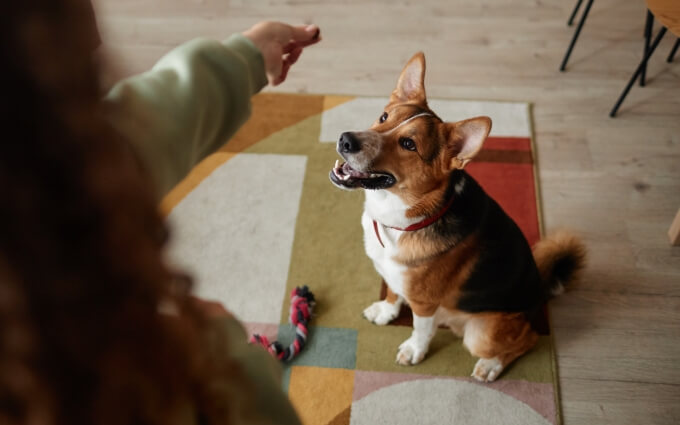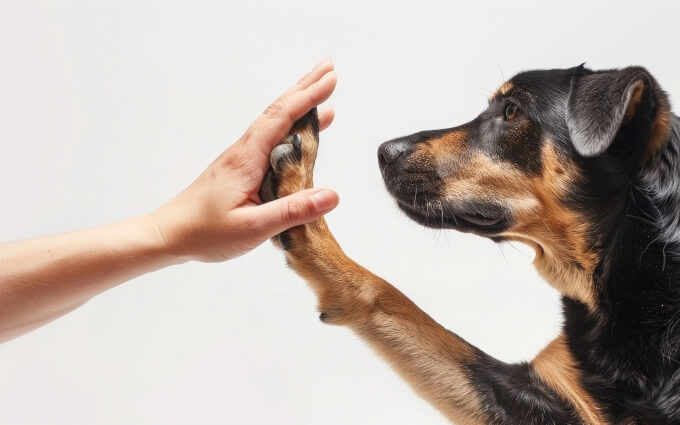- Home
- Tips & Tricks
- Teach Your Dog to Sit
Teach Your Dog to Sit
Discover simple and effective ways to train your dog to sit. Follow our step-by-step guide and succeed with your dog training.

- 39

Why "sit" is important
Teaching your dog to sit on command is one of the most basic and useful skills you can teach them. Not only is it an impressive trick, but it can also help control your dog's behavior in many situations. Whether you're a new dog owner or an experienced trainer, this guide will give you the tools you need to teach your dog to sit effectively.
Preparation: What you need
Before you begin training, it's important to have the right equipment and environment. Here's what you need:
Essential training tools
- Treats:Small, tasty treats that your dog loves.
- Dog leash:A short leash to keep your dog focused.
- Positive voice:Lots of praise and a positive tone of voice.
- Calm environment:A place without too many distractions.
Step-by-step guide to "sit down"
Now that you're ready, it's time to start training. Follow these steps to teach your dog to sit:
Step 1: Grab attention
- Start by holding a treat close to your dog's nose to get their attention.
Step 2: Move the treat
- Slowly move the treat upwards so your dog's head follows it upwards. This will naturally cause its rear end to lower towards the ground.
Step 3: The command "Sit"
- As soon as your dog's rear end hits the ground, say "sit" loud and clear.
Step 4: Reward
- Immediately give your dog the treat and praise them in a positive voice.
Step 5: Repetition
- Repeat the exercise several times daily in short sessions. Consistency is the key to success
Common challenges and solutions
During training, you may encounter some challenges. Here are some common problems and their solutions:
My dog loses interest
- Keep training sessions short and fun. Always end with a success experience.
- Switch between different treats to keep your dog interested.
My dog gets back up quickly
- Train 'sit' together with 'stay' to teach your dog to stay longer.
- Reward your dog when it stays put, even if it's only a few seconds at first.
My dog doesn't understand the command
- Be patient and consistent. Always use the same command and movement.
- Show the dog what you want by physically helping his butt down (gently) while saying "sit".
Advanced techniques: Improving 'sit'
Once your dog has mastered the basic 'sit', you can start introducing more advanced techniques to improve the reliability and usability of the command.
Distance training
- Start giving the command from longer distances. Start with a few meters and gradually increase the distance.
Using hand signals
- Implement a hand signal with the verbal command. This can be useful in noisy environments.
- For example, you can raise your hand flat above your head as a signal to 'sit'.
Distraction training
- Practice the 'sit' command in environments with multiple distractions, like in the park or around other dogs.
- Reward your dog for obeying the command despite the distractions.
Frequently Asked Questions about teaching your dog to sit
How do I teach my dog to sit?
Hold a treat above your dog's head and move it back slightly until your dog naturally sits, then reward immediately.
How long does it take to train a dog to sit?
Many dogs can learn to sit in just a few short training sessions with consistency and rewards.
Can puppies learn to sit?
Yes, puppies can learn to sit from a very young age using positive reinforcement and patience.
Do I need a clicker to teach sit?
No, a clicker is optional, but it can help mark the exact moment your dog performs the behavior.
Why is teaching sit important?
Sit is a basic obedience command that helps with control, focus, and building good manners in dogs.
Conclusion: The importance of patience and positive reinforcement
Training your dog to sit requires patience, consistency and lots of positive reinforcement. Remember that every dog learns at their own pace and the most important thing is to create a positive and supportive training experience. By following this guide and staying patient, you'll soon have a dog that sits on command with joy and confidence.
- 39
 Marcin Solgaard
Marcin Solgaard
Marcin is a true dog enthusiast! He is always seen with his 9-year-old boxer by his side. Marcin believes that dogs thrive on love, fun and positive experiences. On their daily adventures, people often stop Marcin to ask how his boxer is so happy and well-behaved. He happily shares tips on dog behavior and fun activities to create a happy and harmonious life with your dog.
-
Dog Behavior
 Does My Dog Know I Care About It?
Does My Dog Know I Care About It?Discover the ways your dog shows it knows you care and how you can reinforce that loving bond through simple actions and daily interactions.
 Cassandra DalgaardAug 05, 202444
Cassandra DalgaardAug 05, 202444 -
Food & Nutrition
 The Best Foods to Boost Your Dog's Immune System
The Best Foods to Boost Your Dog's Immune SystemTo keep your dog healthy and resilient, fueling their immune system with the right foods is key. In this post, we'll cover the top nutrient-packed foods that can give your dog's immune system the support it needs, helping them fend off illness and stay energetic.
 Marcin SolgaardOct 04, 20249
Marcin SolgaardOct 04, 20249 -
Tips & Tricks
 Are You Ready for Life with a Dog? Everything You Need to Know
Are You Ready for Life with a Dog? Everything You Need to KnowThis guide helps you determine if you're ready for a dog by exploring the responsibilities, financial requirements, and lifestyle changes necessary for successful dog ownership.
 Marcin SolgaardJul 31, 202433
Marcin SolgaardJul 31, 202433 -
Dog health
 Which Emotions Do Dogs Actually Experience? Understanding Your Dog's Emotions
Which Emotions Do Dogs Actually Experience? Understanding Your Dog's EmotionsDogs experience a variety of basic emotions similar to those of a young child. Learn about the emotions your dog truly feels, how they express them, and what it means for your relationship.
 Cassandra DalgaardJul 30, 202478
Cassandra DalgaardJul 30, 202478 -
Tips & Tricks
 How to Train Your Dog to Walk Off-Leash
How to Train Your Dog to Walk Off-LeashThis guide will walk you through everything you need to know, from essential commands to mastering off-leash walks even in distracting environments
 Marcin SolgaardJul 02, 202451
Marcin SolgaardJul 02, 202451 -
Dog Behavior
 Why Does My Dog Put Its Head on Me? Understanding the Behavior
Why Does My Dog Put Its Head on Me? Understanding the BehaviorEver wondered why your dog puts its head on you? This guide dives into the reasons behind this endearing behavior, from seeking comfort to showing love.
 Michelle TorringAug 03, 202428
Michelle TorringAug 03, 202428 -
Dog Behavior
 Why Your Dog Ignores You and How to Change It
Why Your Dog Ignores You and How to Change ItIs your dog ignoring you? Explore the reasons behind this behavior and actionable steps to bring back the focus, from training techniques to environmental adjustments.
 Marcin SolgaardJul 16, 202439
Marcin SolgaardJul 16, 202439 -
Tips & Tricks
 How to Train Your Dog to Give Paw
How to Train Your Dog to Give PawTeaching your dog to give paw is a fun and rewarding experience that strengthens your bond. This guide walks you through the process with tips, tricks, and plenty of paw-sitive reinforcement.
 Marcin SolgaardApr 11, 202441
Marcin SolgaardApr 11, 202441 -
Tips & Tricks
 How to Teach Your Dog to Come When Called
How to Teach Your Dog to Come When CalledThis guide walks you through the process, from selecting the right command to dealing with distractions, ensuring a strong recall every time.
 Marcin SolgaardJul 10, 202448
Marcin SolgaardJul 10, 202448 -
Food & Nutrition
 How to Choose the Right Diet for Your Allergic Dog
How to Choose the Right Diet for Your Allergic DogFind out how to select the perfect diet for your dog with allergies. Learn about elimination diets, hypoallergenic foods, and the best ingredients to keep your furry friend healthy and happy.
 Marcin SolgaardJun 09, 202427
Marcin SolgaardJun 09, 202427










